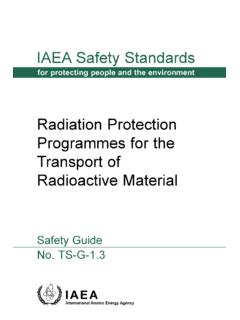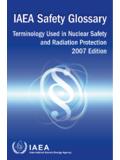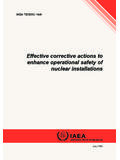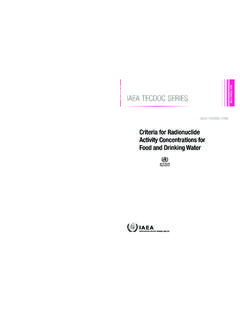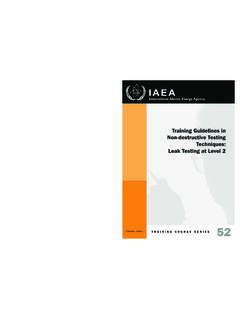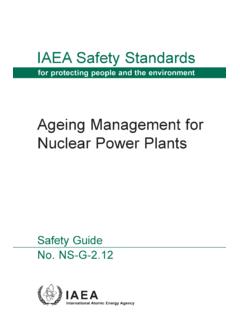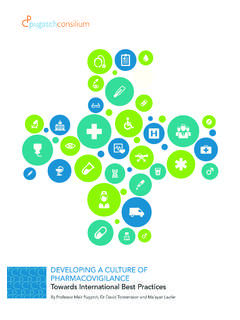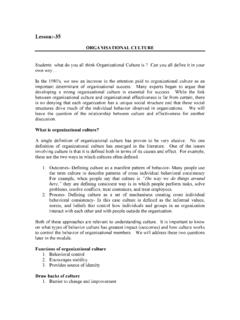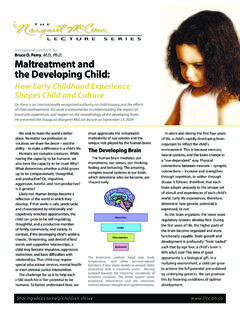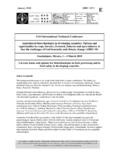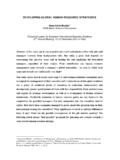Transcription of Low cost options for tissue culture technology in ...
1 IAEA-TECDOC-1384 Low cost options for tissue culture technology in developing countries Proceedings of a Technical Meeting organized by the Joint FAO/IAEA Division of Nuclear Techniques in Food and Agriculture and held in Vienna, 26 30 August 2002 February 2004 The originating Section of this publication in the IAEA was: Plant Breeding and Genetics Section International Atomic Energy Agency Wagramer Strasse 5 Box 100 A-1400 Vienna, Austria LOW COST options FOR tissue culture technology IN developing COUNTRIES IAEA, VIENNA, 2003 IAEA-TECDOC-1384 ISBN 92 0 115903 XISSN 1011 4289 IAEA, 2004 Printed by the IAEA in Austria February 2004 FOREWORDT issue culture technology is used for the production of doubled haploids, cryopreservation, propagating new plant varieties, conserving rare and endangered plants, difficult-to-propagate plants, and to produce secondary metabolites and transgenic plants.
2 The production of high quality planting material of crop plants and fruit trees, propagated from vegetative parts, has created new opportunities in global trading, benefited growers, farmers, and nursery owners, and improved rural employment. However, there are still major opportunities to produce and distribute high quality planting material, crops like banana, date palm, cassava, pineapple, plantain, potato, sugarcane, sweet potato, yams, ornamentals, fruit and forest trees. The main advantage of tissue culture technology lies in the production of high quality and uniform planting material that can be multiplied on a year-round basis under disease-free conditions anywhere irrespective of the season and weather.
3 However, the technology is capital, labor and energy intensive. Although, labor is cheap in many developing countries, the resources of trained personnel and equipment are often not readily available. In addition, energy, particularly electricity, and clean water are costly. The energy requirements for tissue culture technology depend on day temperature, day-length and relative humidity, and they have to be controlled during the process of propagation. Individual plant species also differ in their growth requirements. Hence, it is necessary to have low cost options for weaning, hardening of micropropagated plants and finally growing them in the field. This publication describes options for reducing costs to establish and operate tissue culture facilities and primarily focus on plant micropropagation.
4 It includes papers on the basics of tissue culture technology , low cost options for the design of laboratories, use of culture media and containers, energy and labor saving, integration and adoption of low cost options , and increasing plant survival after propagation, bioreactors, and outreach of material to the growers and farmers in developing countries. Bioreactors in plant propagation can produce millions of plants and may cut down the cost of plant production, which is yet not commonly used in developing countries. However, in the near future it could be well integrated into large scale commercial micropropagation in both developed and developing countries. In all cases, such options must be integrated without reducing the efficiency of plant propagation and compromising the plant quality.
5 This TECDOC was prepared on the basis of contributions made by the participants in the Technical Meeting on Low Cost tissue culture technology for developing Countries, Vienna, 26 30 August 2002. This publication should be of great value to plant propagators, managers of tissue culture laboratories, scientists, organizations contemplating the establishment of new laboratories, and ongoing commercial concerns, all of whom may wish to incorporate low cost options into their day-to-day operations. Also, it would greatly serve plant propagation enterprises in developing countries with scarce funds and poor infrastructure for sustainable food production.
6 Many of the options described can also be integrated in tissue culture laboratories that use mutation induction to develop new mutant varieties of both vegetatively and seed propagated plants, and for rapid release of the selected mutants. The IAEA and FAO wish to thank Ahloowalia, former staff member of the Joint FAO/IAEA Division of Nuclear Techniques in Food and Agriculture, for compiling and preparing this publication. The IAEA officer responsible for the publication is S. Mohan Jain. EDITORIAL NOTEThis publication has been prepared from the original material as submitted by the authors. The views expressed do not necessarily reflect those of the IAEA, the governments of the nominating Member States or the nominating organizations.
7 The use of particular designations of countries or territories does not imply any judgement by the publisher, the IAEA, as to the legal status of such countries or territories, of their authorities and institutions or of the delimitation of their boundaries. The mention of names of specific companies or products (whether or not indicated as registered) does not imply any intention to infringe proprietary rights, nor should it be construed as an endorsement or recommendation on the part of the IAEA. The authors are responsible for having obtained the necessary permission for the IAEA to reproduce, translate or use material from sources already protected by .. 1 Plant tissue culture .
8 Ahloowalia, J. Prakash, Savangikar, C. Savangikar Role of low cost options in tissue culture .. 11 Savangikar Physical components of tissue culture Ahloowalia, J. Prakash culture media and containers ..29S. Prakash, Hoque, T. BrinksLow cost options for energy and labour .. Ahloowalia, Savangikar Bioreactors as a low cost option for tissue 47 R. Levin, G. Tanny Disease detection and elimination .. 55J. Schmidt, E. Wilhelm, Savangikar Quality assurance .. Savangikar, C. Savangikar Priming tissue cultured propagules .. 69 J. Nowak, K. Pruski Incorporation of low cost options .. Ahloowalia, J. Prakash Integration of technology from lab to land .. 87 Ahloowalia Summary .. 91 Equipment checklist.
9 95 Commonly used terms in tissue culture .. 99 Abbreviations .. 101 Composition of the commonly used media .. 102 Related publications .. 103 Papers and 103 List of Participants .. 105 INTRODUCTIONThe large scale commercial propagation of plant material based on plant tissue culture was pioneered in the USA. During the last thirty years, tissue culture -based plant propagation has emerged as one of the leading global agro-technologies. Between 1986 and 1993, the worldwide production of tissue cultured plants increased 50%. In 1993, the production was 663 million plants. By 1997, production had risen to 800 million plants. During 1990 1994, the micropropagation industry declined in Europe, mainly due to production shifting to developing countries, but since then because of the demand for high quality and number, production in European countries has increased.
10 Since 1995, production has increased by 14% in Asian countries, mainly due to the market entry of China, while the increase in South and Central America was from production in Cuba. More recently, some companies from Israel, the USA and UK have shifted their production requirements to Costa Rica and India. tissue cultured plants have as yet to reach many growers and farmers in the developing countries. The primary advantage of micropropagation is the rapid production of high quality, disease-free and uniform planting material. The plants can be multiplied under a controlled environment, anywhere, irrespective of the season and weather, on a year-round basis. Production of high quality and healthy planting material of ornamentals, and forest and fruit trees, propagated from vegetative parts, has created new opportunities in global trading for producers, farmers, and nursery owners, and for rural employment.
